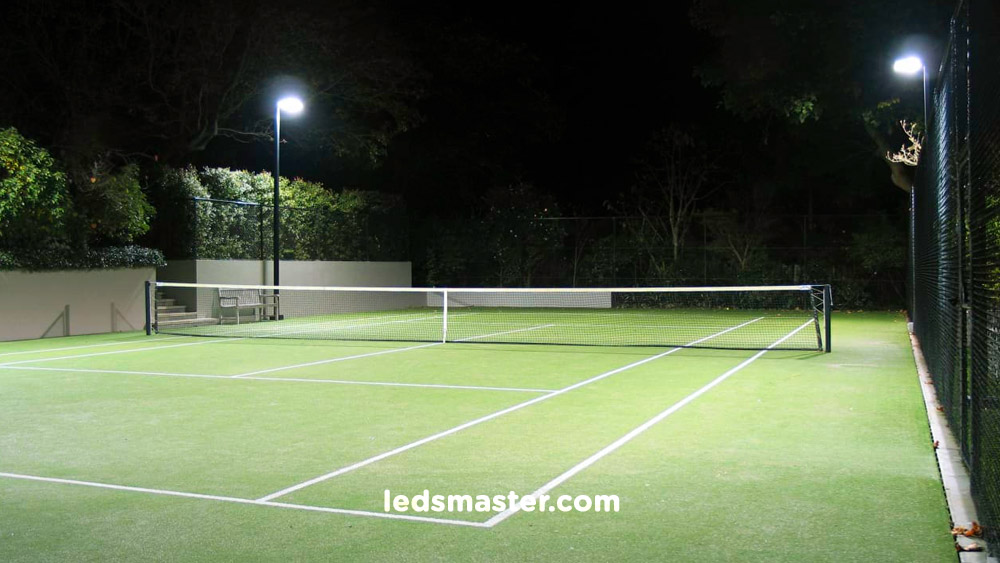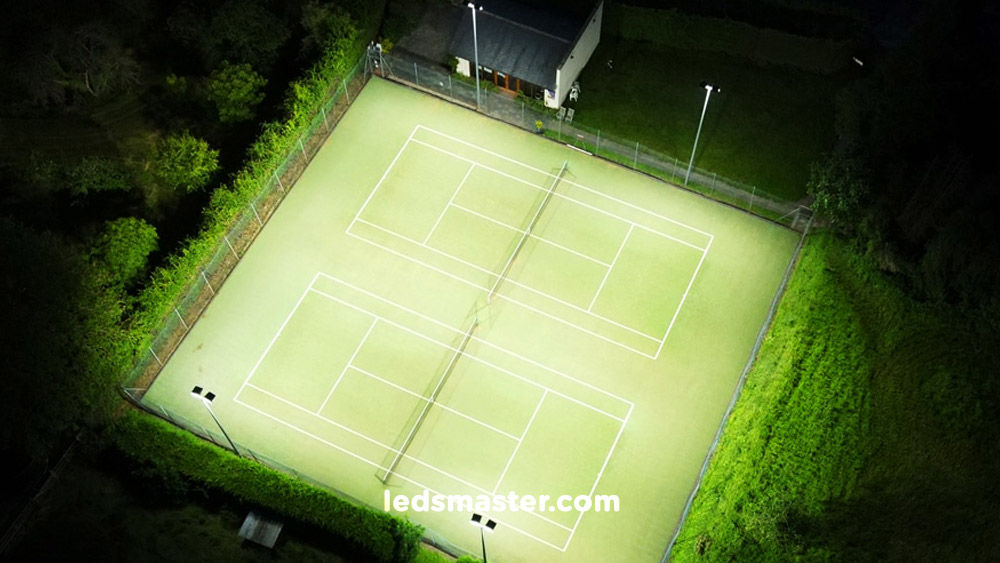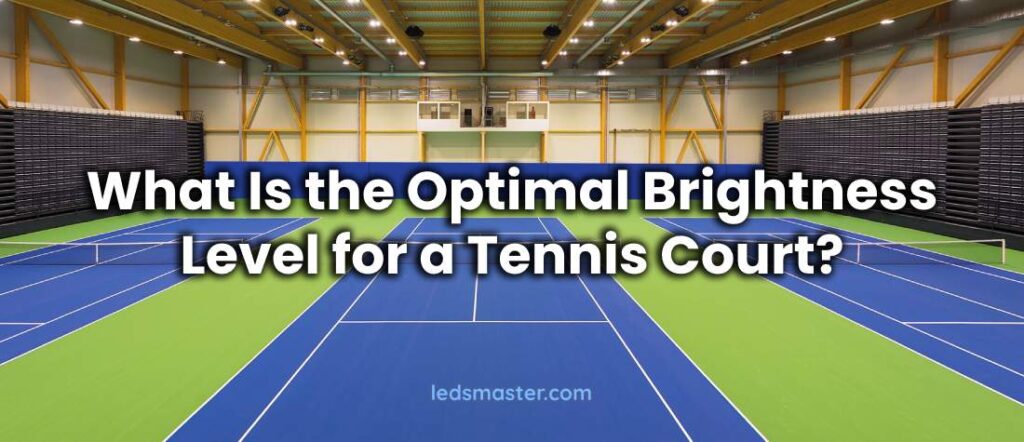When considering the lighting of tennis courts, a common question arises regarding the ideal brightness level. Understanding this largely hinges on grasping the fundamental principles of tennis court illumination. The appropriate brightness ensures players can track the ball accurately and react swiftly. Factors such as uniformity of lighting and minimizing glare are crucial to providing optimal visibility across the court. By adhering to these principles, determining the right brightness for tennis courts becomes straightforward and ensures an enhanced playing experience for athletes and spectators alike.
Table of Contents
ToggleWhat is the Standard for Measuring the Brightness of Tennis Courts?
To determine the brightness of a tennis court, a practical method involves using a lux meter. If you don’t have access to a physical lux meter, you can download an app called ‘Lux Meter’ from your app store. By placing your phone face up on the court surface, you can measure the lux value accurately.
During daylight hours, the lux levels on a tennis court typically range from 30,000 to 80,000 lux, and in some cases, even up to 100,000 lux. This indicates higher levels of natural or artificial light contribute to higher lux readings.
At night, the brightness of a tennis court is regulated according to lighting standards, generally falling between 200 lux to 1,000 lux. These standards ensure sufficient visibility for players while minimizing glare and ensuring uniform lighting across the court.
What is the Recommended Brightness Level for a Tennis Court?

So, what exactly should the brightness of a tennis court be? Generally, the recommended brightness ranges from 200 to 1,000 lux.
The specific lux level can vary based on the type of tennis facility. For instance, a casual tennis club typically requires around 200 to 300 lux. In contrast, prestigious international tournaments like the ATP Tour or Wimbledon necessitate higher illumination levels, often reaching up to 1,000 lux.
| Function of the tennis court | Brightness required | Lumens required |
| Recreational and training | 200 lux to 300 lux | 60,000 to 80,000 lumens |
| Regional tennis matches | 400 lux to 750 lux | 120,000 to 160,000 lumens |
| National and international tennis tournaments | up to 1,500 lux | 400,000 to 600,000 lumens |
Referring to the table above, it becomes evident that tennis facilities aspiring to host professional tournaments require an increased number of courts. Consequently, the corresponding lumens needed for adequate illumination must also rise accordingly.
If your tennis court currently has lighting in place, a practical method to assess its adequacy is by placing your phone on the court surface to measure the lux value. If the reading falls below 200 lux, it indicates the need for replacement and installation of new lighting fixtures.
Opting for LED tennis court lighting presents several advantages. LEDs boast an impressive lifespan exceeding 150,000 hours, reducing the frequency of light replacements. Moreover, LED technology offers substantial energy savings, typically between 75% to 85% compared to traditional metal halide lights. LEDs also outperform traditional options in terms of glare reduction, dimming capabilities, and operational efficiency. Thus, choosing LED lights not only benefits tennis court users and owners but also enhances the experience for spectators.
What Should Be Done if the Tennis Court Lights Are Too Bright?

Optimal brightness is crucial for tennis courts as excessive brightness can lead to various issues. Tennis courts should not be overly bright due to the potential for glare, which can cause discomfort to players and spectators alike. Prolonged exposure to glare may result in eye strain, making it difficult to focus on the game. Moreover, studies suggest that excessive glare can trigger migraines and headaches among individuals exposed to overly bright tennis court lighting.
Therefore, achieving the right balance of brightness is essential. Tennis court lighting should provide sufficient illumination for players to see clearly without causing discomfort or health issues due to glare. This balance not only enhances the playing experience but also ensures the well-being of everyone involved in enjoying or participating in tennis matches.
What Are the Solutions to Excessive Brightness in Tennis Court Lighting?
Selecting the appropriate number of lighting fixtures and lumens is key to addressing tennis court lighting needs effectively. For recreational tennis courts, typically 4 to 8 lights are sufficient to ensure adequate illumination. High school tennis courts often require a greater number, ranging from 8 to 16 lights, to meet the higher standards necessary for competitive play. In contrast, professional tennis courts demand a substantial number of lights, often reaching up to 100, to meet the rigorous requirements of international tournaments.
For more detailed guidance on tennis court lighting requirements, including lumens specifications tailored to specific needs, feel free to reach out to our engineers. We offer complimentary lighting consultations to assist you in making informed decisions that optimize the performance, energy efficiency, and visual comfort of your tennis court lighting system.
What Should Be Done if the Lighting of a Tennis Court Is Insufficiently Bright?
Inadequate lighting on a tennis court, defined as lux levels below 200 lux, poses several drawbacks. Insufficient brightness can strain the eyes of players and spectators alike, diminishing visibility and potentially hindering the enjoyment of the game. Clear visibility of fast-moving tennis balls becomes compromised, impacting the overall quality of the match experience. While dimly lit tennis courts consume less energy, prioritizing low lux levels compromises optimal lighting design for tennis play. It’s essential to maintain lux and lumen levels within a specific range to ensure adequate illumination for players and spectators.
Balancing brightness levels is crucial for tennis court lighting to enhance visibility without causing discomfort or impairing performance. Ensuring that lux and lumen requirements are met optimizes conditions for players to track the ball accurately and react swiftly during gameplay. This approach not only improves the quality of matches but also enhances safety and enjoyment for everyone involved in tennis activities.
Conclusion
Achieving the ideal brightness for tennis courts is essential for optimizing gameplay and spectator experience alike. Proper illumination, measured in lux, ensures players can track the ball accurately and react swiftly, while also minimizing discomfort from glare. Whether adjusting existing lighting or installing new fixtures, maintaining balanced lux and lumen levels tailored to specific needs—from recreational clubs to professional tournaments—promotes safety, enhances performance, and enriches the overall enjoyment of tennis matches for all participants and spectators.

